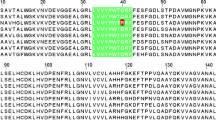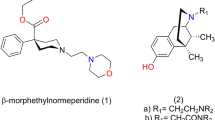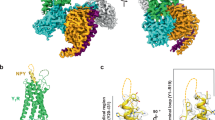Abstract
Attention has recently focused on the possible biological roles of peptides related to β-1ipotropin (β-LPH)1,2. In particular, observations suggest that certain peptide fragments derivable from β-LPH, including γ-endorphin (β-LPH61–77) and α-endorphin (β-LPH61–76), may be involved in various modes of behavioural adaptation2,3. Structure–activity studies on behavioural actions of γ-endorphin, an opioid peptide, revealed that the omission of N-terminal tyrosine resulted in a non-opioid peptide, des-Tyr-γ-endorphin, which exhibited greater behavioural activity than γ-endorphin3. Subsequent biochemical studies provided evidence for the association with brain synaptic plasma membranes of peptidase activities which could produce γ- and α-endorphins and their des-Tyr derivatives from exogenous β -endorphin4. This and earlier observations4ndash;6 suggest that regulatory physiological events are focused on the N-terminal tyrosine residue; enzymatic reactions exerted at this residue are thus of great interest. We recently purified to homogeneity an aminopeptidase from bovine brain which catalyses the hydrolysis of Met5- or Leu5-enkephalin by sequential release of amino acids from the amino terminus of the enkephalin molecule7. The ability of this enzyme, purified from bovine7, monkey8 or rat9 brain, to use endorphins as substrates has not been previously examined. We now present quantitative studies which show that homogeneous bovine brain enkephalin aminopeptidase catalyses the hydrolysis of the N-terminal tyrosine from γ-, α- and β -endorphins with substantial turnover numbers and yields only the des-Tyr derivatives. These results suggest that this enzyme may be involved in regulating the concentrations of opioid- and opioid-derived biologically active peptides in the brain.
This is a preview of subscription content, access via your institution
Access options
Subscribe to this journal
Receive 51 print issues and online access
$199.00 per year
only $3.90 per issue
Buy this article
- Purchase on Springer Link
- Instant access to full article PDF
Prices may be subject to local taxes which are calculated during checkout
Similar content being viewed by others
References
Rossier, J. et al. Nature 270, 618–620 (1977).
deWied, D. in Characteristics and Functions of Opioids (eds VanRee, J. M. & Terenius, L.) 113–122 (Elsevier, Amsterdam, 1978).
deWied, D., Kovacs, G. L., Bohus, B., VanRee, J. M. & Greven, H. M. Eur. J. Pharmac. 49, 427–436 (1978).
Burbach, J. P. H. et al. Nature 283, 96–97 (1980).
Frederickson, R. C. A. Life Sci. 21, 23–42 (1977).
Smyth, D. G., Massey, D. E., Zakarian, S. & Finnie, M. D. Nature 279, 252–254 (1979).
Hersh, L. B. & McKelvy, J. F. J. Neurochem. (in the press).
Hayashi, M. J. Biochem. 84, 1363–1372 (1978).
Schnebli, H. P., Phillips, M. A. & Barclay, R. K. Biochim. biophys. Acta 569, 89–98 (1979).
Felgner, P. L., Messer, J. L. & Wilson, J. E. J. biol. Chem. 254, 4946–4951 (1979).
Fonnum, F. Biochem. J. 109, 389–398 (1968).
Author information
Authors and Affiliations
Rights and permissions
About this article
Cite this article
Hersh, L., Smith, T. & McKelvy, J. Cleavage of endorphins to des-Tyr endorphins by homogeneous bovine brain aminopeptidase. Nature 286, 160–162 (1980). https://doi.org/10.1038/286160a0
Received:
Accepted:
Issue Date:
DOI: https://doi.org/10.1038/286160a0
This article is cited by
-
Puromycin-sensitive aminopeptidase is the major peptidase responsible for digesting polyglutamine sequences released by proteasomes during protein degradation
The EMBO Journal (2007)
-
Membrane-bound enzymes and their role in processing of the dynorphins and of the proenkephalin octapeptide Met-enkephalin-Arg-Gly-Leu
Neurochemical Research (1984)
Comments
By submitting a comment you agree to abide by our Terms and Community Guidelines. If you find something abusive or that does not comply with our terms or guidelines please flag it as inappropriate.



